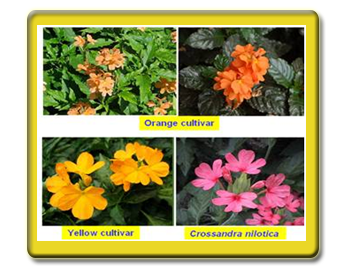CROSSANDRA (Crossandra infundibuliformis L.)
Acanthaceae
Varieties
Tetraploid types - Orange, Lutea Yellow, Sebaculis Red.
Triploid types - Delhi Crossandra.
Climate: It requires a temperature of 30 - 35°C for growth. It is shade tolerant to some extent but susceptible to low temperature and frost.
Soil: Well drained sandy loam and red soils with pH of 6 - 7.5 are ideal. Soil is to be tested for nematodes before planting.
Propagation:
Tetraploids: Propagated through seeds. Seed rate is 5kg/ha. 60 day old seedlings are transplanted in the main field.
Triploids: Propagated through terminal cuttings of 10 - 15 cm length (41,700 cuttings/ha)
Seeds and sowing
Fresh seeds are sown during July - October in raised beds at 15 cm apart in lines. Watering should be done daily. The seedlings will be ready for transplanting in 60 days.
Seed rate
The required seed rate is 5 kg/ha for optimum plant population. For Delhi Crossandra, rooted cuttings have to be used for planting.
Preparation of field
Land is ploughed thrice and FYM at 25 t/ha is incorporated. Ridges are formed 60 cm apart. Dip the roots of seedlings in Carbendazim (1 g/l of water) and plant on one side of the ridge at 30 cm spacing. For seed production the spacing may be 60 x 60 cm. For Delhi Crossandra a spacing of 60 x 40 cm is to be followed.
After cultivation
Spray Diuron (pre-emergence) 2.5 kg a.i/ha for controlling the weeds.
Manuring
Tetraploids: Apply FYM 25 t/ha as basal and NPK at 75, 50 and 125 kg/ha as top dressing three months after planting. Repeat NPK application at the same dose at half yearly intervals for two more years (Instead of applying N at 75 kg/ha, N at 60 kg/ha + Azospirillum 2 kg/ha can also be applied).
Delhi Crossandra: Apply FYM 25 t/ha, Gypsum 100 kg/ha and P & K at 50 and 100 kg/ha respectively as basal dose. Top dressing is done 30 days after planting with neem cake 250 kg and N 40 kg/ha. Apply N P K @ 40:20:60 kg/ha 90 days after planting and repeat this dose at quarterly intervals for a period of two years.
For both Tetraploids& Delhi Crossandra:
Biofertilizers: Soil application of2 kg each of Azospirillum and Phosphobacteria per ha at the time of planting. It is to be mixed with 100kg of FYM and applied.
Growth regulators: Spray Ascorbic acid 1000 ppm (1 g/lit of water) before flowering.
Top Dressing
On 30 days after planting, apply Neem cake 250 kg and N 40 kg/ha. Again on 90 days after planting apply N P K 40:20:60 Kg and repeat this dose at quarterly intervals for a time period of two years.
Irrigation
Irrigation is done once in a week.
Plant protection
Pests
Nematode
Avoid planting Crossandra in nematode infested fields. To control nematodes, apply Phorate or Carbofuran 3 G at 1 kg a.i./ha a week after planting and the same may be repeated siz months after planting.
Aphids
To control aphids, spray Dimethoate 30 EC 2 ml/lit.
Disease
Wilt
Soil drenching with Carbendazim 1 g/lit or Triflooxystrobin + tebuconazole @ 0.75 g/litre
Crop duration
3 years including ratoon crop.
Harvest
Flowering will start a month after transplanting. Fully opened flowers are picked once in two days.
Yield
An average yield of 2000 kg of flowers per ha/year can be obtained. In Delhi Crossandra, 2800 kg of flowers per ha per year can be obtained.
Source
1. http://www.floridaplants.com/earthworks/james2.htm
2. http://farm3.static.flickr.com/2010/2478613985_95062b4e18.jpg
3. www.flickr.com/photos/36299099@N00/2368539362
4. http://www.metafro.be/prelude/prelude_pic/Crossandra_nilotica1.jpg
5. http://upload.wikimedia.org/wikipedia/commons/4/4f/Crossandra_infundibuliformis_2008.JPG
|

